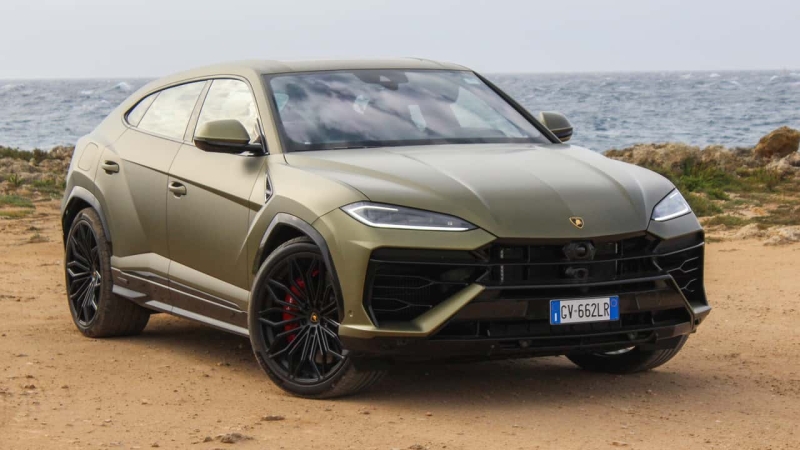The Urus SE gets a V-8 with an electric motor and a reworked drivetrain. The changes make Lamborghini’s SUV worth considering.
Brian Silvestro / Motor1, Lamborghini
I’ve never really taken the Lamborghini Urus seriously. It has the flashy looks to back up the badge, sure, but with an engine and chassis borrowed from Volkswagen Group and an interior clad in Audi switchgear, the original Urus could never evoke the same passion as Lamborghini’s low-slung, high-revving sports cars.
That thinking changes with the Urus SE, the SUV’s first hybrid variant. New for 2025, the SE (pronounced ess-ay) brings a host of visual improvements and, most importantly, a revamped all-wheel drive system to supplement the extra torque provided by a single electric motor mounted between the V-8 and the eight-speed automatic. After a brief test at the Nardò Technical Center in southern Italy, it’s clear this super SUV should be front-of-mind for buyers who want a car that can do everything—including put a smile on their face.
| Quick Specs | 2025 Lamborghini Urus SE |
| Engine | Twin-Turbo 4.0-Liter V-8 Plug-In Hybrid |
| Transmission | Eight-Speed Automatic |
| Output | 789 Horsepower / 701 Pound-Feet |
| 0-60 MPH | 3.4 seconds |
| Base Price / As-Tested Price | $258,636 / $285,000 (est.) |
The switch from Urus to Urus SE is easy to spot in some places, but harder in others. The front end incorporates a new hood that stretches all the way over the grille and bumper, eliminating the last-gen’s unsightly shutline. The headlights are slimmer and equipped with a new daytime running light design that Lamborghini says was inspired by the bull’s tail in its logo. And there’s a new fake grille piece along the trunk lid that connects the taillights, complete with the company’s signature hexagon pattern.
This new design borrows more from the original concept shown in 2012, with its sleeker nose and smoother lights. Otherwise, the Urus SE is mostly similar to before—and equally as polarizing. Does this lightly updated Urus provoke the same reactions as a Revuelto? Absolutely not. But it’s still decidedly exotic for an SUV.
The Urus SE attempts to keep pace inside with soft leather and hexagonal patterns scattered throughout. There’s a lovely trio of levers—inspired by the cockpit of an airplane—to select gears, switch between drive modes, and adjust battery settings. This interior remains a nice place to spend time, but if you’ve driven any Audi in the past five years, it will all feel very familiar.
The dual 12.3-inch screens for infotainment and climate control are lifted straight from the Q8, albeit with Lamborghini’s own hexagon-themed software skin. Trim pieces, like those that house the volume knob and the window switches, are also Audi-sourced. Even the buttons on the steering wheel are adorned in Audi font.
Despite what the interior might suggest, the Urus SE drives nothing like an Audi. Pull the drive mode lever to Corsa mode, and you’re treated to savage acceleration as the front wheels claw for traction. Combined, the twin-turbo 4.0-liter engine and the electric motor deliver a gargantuan 789 horsepower and 701 pound-feet of torque. Lamborghini quotes a 3.4-second 0-60 sprint, but it feels quicker. Much quicker.
That’s thanks to the electric motor, turbo lag is a thing of the past for the Urus; The hybrid system torque-fills on the low end of the rev range to ensure you’re never without instant thrust. In Sport and Corsa modes, the car feels fully electric in the way every minute input from the throttle translates into an immediate jump forward. Power doesn’t dip even a little bit on the way to a 6,800-rpm redline.
Engineers threw every piece of tech in the book at the Urus SE to ensure it could handle as well as a car half its weight. There are semi-active dampers, active anti-roll bars, and rear-wheel steering to coax the car effortlessly through corners. The steering is almost BMW-like in how quickly the rack responds to inputs. Feedback from the front tires is marginal at best, but after feeling how naturally the car pivots beneath you, lack of sensation is easy to forgive.
Even more important than the chassis gizmos are the changes made to the drivetrain. The previous Urus had a Torsen-style transfer case splitting power front to rear, making it tough for engineers to fine-tune torque distribution. That’s gone, replaced by a multi-clutch transfer case that can send as much power as needed to either end of the car in the blink of an eye. Similarly, the rear end’s been equipped with an electronic limited-slip differential, unlocking a far wider range of possibilities for controlling traction during cornering phases like turn-in and corner exit.
The upgrades are immediately noticeable on a loose surface. To get a feel for how the Urus SE handles at the limit, Lamborghini let me loose on a dirt test track at Nardò. Even with traction control on, the drivetrain defaults to generating yaw and keeping the nose in check, allowing for easy sideways transitions and big, creamy four-wheel drifts. On the dirt, the Urus SE feels like a well-tuned STI, except with more than double the power. And even with all that magic happening underneath, it doesn’t feel forced or unnatural.
It’s a lot tougher for something this heavy to translate that neutral feeling to pavement, but the Urus does so with ease. On a dry asphalt drift course, it was incredibly simple to lock in gigantic, smoky drifts and transition sideways from left to right. Those 360s you see Travis Pastrana doing in those Subaru stunt videos? Easy work for this thing.
On the road, it becomes clear that the Urus SE defaults all its torque to the rear in Sport and Corsa modes. And thanks to the instant response from the electric motor, it’s dead-easy to kick out the rear for cute little slides, even at safe speeds with the traction control on.
The Urus SE is a bonafide driver’s SUV, then. It’s exceptionally quick and agile, and capable of feats you wouldn’t expect of a vehicle this size, whether you’re on pavement or otherwise. Anyone who loves driving can find joy in this thing, so long as they’re content with the cost of replacing tires.
But I still struggle to assign the Urus the title of a “real” Lamborghini. Growing up, I only knew this brand for building one type of car: Brash, unapologetic, otherworldly machines that looked like spaceships and sounded like rocket ships. In my mind, a Lamborghini has a very specific silhouette. And that silhouette is not the shape of a four-door SUV.
Not that my opinion matters. Looking at sales, I’m clearly in the minority. After the Urus debuted in 2017, it essentially doubled the size of the company, immediately skyrocketing to become the best-selling car in Lamborghini’s lineup by nearly double the next-best-selling model, the Huracán. CEO Stephan Winkelmann rightfully looks at the Urus as the bedrock of the brand.
“The Urus is allowing us to have a pillar which is enabling us to invest into the future even more for the super sports car business,” Winkelmann told Motor1.
“Lamborghini has never been only about supercars,” he added. “We started with GT cars in the 1960s and then also the LM002 in the early 1980s. When we have the lineup new and running, it will be 50 percent supercars and 50 percent Urus.”
The Urus SE is sold out through 2025, with more than 50 percent of orders being return customers who are simply upgrading to the newest model. Purists on the sideline like me might be butt-hurt by the brand’s dilution, but buyers seem fully on board. Now I know what it must’ve been like for freaks like me in the early 2000s when Porsche introduced the Cayenne.
Whether you think the Urus SE is a “real” Lamborghini or not, you shouldn’t dismiss it. I can’t think of a direct competitor with better dynamics (that I’ve driven, anyway). The Porsche Macan GTS remains my favorite SUV for carving backroads, but it’s smaller, cheaper, and far less exotic. The Ferrari Purosangue is more enjoyable and certainly more visceral thanks to its V-12, but it’s less practical and the infotainment system is offensively bad. It’s also double the price.
While the Cayenne Turbo GT—which I haven’t driven—might be the most logical comparison, Range Rovers, Cullinans, Bentaygas, and G-Wagens will be the Urus’s most likely competitors. The Lamborghini’s biggest markets are places like Los Angeles and Miami, where presence and clout trump driving dynamics every time. With most of these things relegated to mall-crawler duty, at least Urus SE owners will know their car is the most fun thing in the parking lot.
Brian Silvestro / Motor1, Lamborghini
Competitors
- Aston Martin DBX
- Bentley Bentayga Speed
- Porsche Cayenne Turbo GT
- Mercedes-AMG G63
Get the best news, reviews, columns, and more delivered straight to your inbox, daily. Sign up For more information, read our
Privacy Policy and Terms of Use.
Lamborghini Urus
Engine 4.0-Liter Twin-Turbo V-8 Plug-In Hybrid
Motor Single Permanent-Magnet Synchronous
Output 789 Horsepower / 701 Pound-Feet
Transmission Eight-Speed Automatic
Drive Type All-Wheel Drive
Battery 25.9-kWh
Speed 0-60 MPH 3.4 Seconds (mfr.)
Maximum speed 194 MPH (mfr.)
Weight 5,522 Pounds (mfr.)
Efficiency 14 City / 19 Highway / 16 Combined (est.)
EV Range 37 Miles (European Cycle)
Seating Capacity 5
On Sale Late 2024
Base Price $258,636
As-Tested Price $285,000 (est.)



